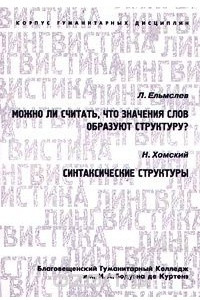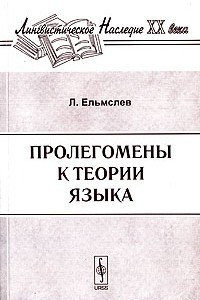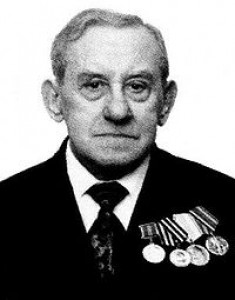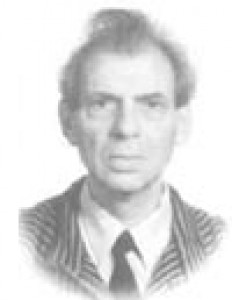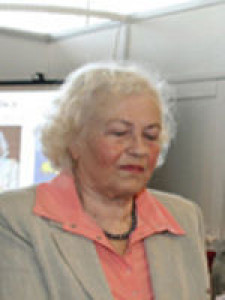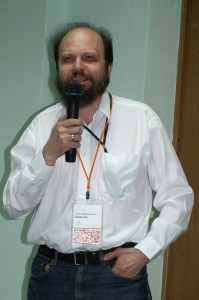-
Жанры
-
Художественная литература
- Приключения 75083
- Фантастика 100897
- Фэнтези 73474
- Детектив 59379
- Ужасы 48028
- Роман 70045
- Классическая литература 60314
- Историческая проза 8094
- Современная проза 141702
- Детская литература
- Культура и искусство
- Научная литература
- История
- Бизнес
- Прикладная литература
- Документальная литература
- Образование
- Дом и семья
- Физическая культура
- Здоровье
- Литература на иностранных языках
-
Художественная литература
- Книги
- Рецензии
- Сообщество
- Блоги
- Цитаты
- Тесты
- Подборки
- Премии
- Конкурсы
- Другое

Луи Ельмслев
Краткая биография автора
Луи Тролле Е́льмслев (дат. Louis Trolle Hjelmslev, 3 октября 1899 — 30 мая 1965) — датский лингвист. Автор глоссематики — оригинальной структуралистской теории языка, имеющей значительную математическую составляющую (язык рассматривается как частный случай семиотических систем, как структура, которую можно строго формализовать в духе требований математики, логики и семиотики).Родился в Копенгагене в семье математика Иоганна Ельмслева (датск.)русск. (1873—1950).Учился в Копенгагенском университет...
Луи Тролле Е́льмслев (дат. Louis Trolle Hjelmslev, 3 октября 1899 — 30 мая 1965) — датский лингвист. Автор глоссематики — оригинальной структуралистской теории языка, имеющей значительную математическую составляющую (язык рассматривается как частный случай семиотических систем, как структура, которую можно строго формализовать в духе требований математики, логики и семиотики).Родился в Копенгагене в семье математика Иоганна Ельмслева (датск.)русск. (1873—1950).Учился в Копенгагенском университете, позже в университете Орхуса (датск.)русск.. Работал в Копенгагенском университете. В 1931 году вместе с Виго Брёндалем (датск.)русск. стал одним из основателей Копенгагенского лингвистического кружка, в течение многих лет был председателем этого общества.Скончался в Ордрупе (датск.)русск. (сейчас это пригород Копенгагена). Похоронен на местном кладбищеLouis Trolle Hjelmslev (Danish pronunciation: [ˈjεlˀmsleʊ]) (October 3, 1899, Copenhagen – May 30, 1965, Copenhagen) was a Danish linguist whose ideas formed the basis of the Copenhagen School of linguistics. Born into an academic family (his father was the mathematician Johannes Hjelmslev), Hjelmslev studied comparative linguistics in Copenhagen, Prague and Paris (with a.o. Antoine Meillet and Joseph Vendryes). In 1931, he founded the Cercle Linguistique de Copenhague. Together with Hans Jørgen Uldall he developed a structural theory of language which he called glossematics, which developed the semiotic theory of Ferdinand de Saussure. Glossematics as a theory of language is characterized by a high degree of formalism, it is interested only in describing the formal characteristics of language, and a high degree of logical rigour. The theory never became widely influential, but has recently been picked up by post-structuralist philosophers as a possible alternative to the dominant saussurean linguistic paradigm.The Linguistic Circle of CopenhagenThe Linguistic Circle of Copenhagen was founded by Hjelmslev and a group of Danish colleagues on 24 September 1931. Their main inspiration was the Prague Linguistic Circle, which had been founded in 1926. It was, in the first place, a forum for discussion of theoretical and methodological problems in linguistics. Initially, their interest lay mainly in developing an alternative concept of the phoneme, but it later developed into a complete theory which was coined glossematics, and was notably influenced by structuralism. Membership of the group grew rapidly and a significant list of publications resulted, including an irregular series of larger works under the name Travaux du Cercle Linguistique de Copenhague. A Bulletin was produced, followed by an international journal for structuralistic research in language, Acta Linguistica (later called Acta Linguistica Hafniensia), which was founded with the members of the Prague Linguistic Circle. It was, at that time, the sole journal explicitly dedicated to structuralism. With one short break from 1934 to 1937, while he lectured at the university of Aarhus, Hjelmslev acted as chairman of the Circle until shortly before his death in 1965.[3] Theoretical workHjelmslev published his first paper at the age of 25. His first major book, Principes de grammaire générale, which he finished in 1928, is an invaluable source for anyone interested in Hjelmslev's work. During the 1930s Hjelmslev wrote another book, La catégorie des cas, which was a major contribution to linguistics. In this book, Hjelmslev analysed the general category of case in detail, providing ample empirical material supporting his hypotheses. It is important to read Hjelmslev's work as a continuous evolving theory on the epistemology of linguistics.His most well-known book, Omkring sprogteoriens grundlæggelse, or in English translation, Prolegomena to a Theory of Language, first published in 1943, critiques the then-prevailing methodologies in linguistics as being descriptive, even anecdotal, and not systematising. He proposed a linguistic theory intended to form the basis of a more rational linguistics and a contribution to general epistemology. Like Ferdinand de Saussure (1857–1913), he accepted language as a system of signs, from the point of view of language use. He argued that a theory of semiotics should be consistent within itself, comprehensive, and as simple as possible.[4] Hjelmslev's sign modelHjelmslev's sign model is a development of Saussure's bilateral sign model.[5] Saussure considered a sign as having two sides, signifier and signified, and also distinguished between form and substance. Hjelmslev's famously renamed signifier and signified as respectively expression plane and content plane.[5][6][7][8] The combinations of the four would distinguish between form of content, form of expression, substance of content, and substance of expression.[5] In Hjelmslev's analysis, a sign is a function between two forms, the content form and the expression form, and this is the starting point of linguistic analysis. However, every sign function is also manifested by two substances: the content substance and the expression substance. The content substance is the psychological and conceptual manifestation of the sign. The expression substance is the material substance wherein a sign is manifested. This substance can be sound, as is the case for most known languages, but it can be any material support whatsoever, for instance, hand movements, as is the case for sign languages, or distinctive marks on a suitable medium as in the many different writing systems of the world.In short, Hjelmslev was proposing an open-ended, scientific method of analysis as a new semiotics. In proposing this, he was reacting against the conventional view in phonetics that sounds should be the focus of enquiry. Some[who?] have interpreted his work as if Hjelmslev argued that no sign can be interpreted unless it is contextualised—treating his functives, expression and content as the general connotative mechanisms (for instance by Algirdas Julius Greimas) -- for Hjelmslev the point of view of the linguist on meaning is that of the form of content. Even if the content substance is important, one has to analyse it from the point of view of the form. Not only do pictures and literature manifest the same organising principles, but, more broadly, seeing and hearing, though certainly not identical, interact in surprisingly complex ways at deeper levels of the sign hierarchy which Hjelmslev sought to understand.[9] AssessmentHjelmslev made a bold proposal to transform technical analysis into a broad enquiry, emphasising that the true focus of linguistics should be the language and the human culture that continually reinvents it, and all society's memory of its accumulated knowledge preserved through language. This was a challenging but constructive argument at the time, and remains one that still has relevance today. Most conspicuously, Hjelmslev's lines of inquiry have been taken up by Gilles Deleuze and Félix Guattari (see the "Postulates of Linguistics" and "Geology of Morals" chapters of A Thousand Plateaus), and subsequently their followers. TerminologyHjelmslev introduced the terms glosseme, ceneme, prosodeme and plereme as linguistic units, analogous to phoneme, morpheme etc.[10]Also, his most famous work, Prolegomena to a Theory of Language, is mostly concerned with the formal definition of a terminology for the analysis of any level of a system of signs, and as such there exists an exclusively Hjelmslevian terminology for that.
На нашем книжном сайте Вы можете скачать книги автора Луи Ельмслев в самых разных форматах (epub, fb2, pdf, txt и многие другие). А так же читать книги онлайн и бесплатно на любом устройстве – iPad, iPhone, планшете под управлением Android, на любой специализированной читалке. Электронная библиотека КнигоГид предлагает литературу Луи Ельмслев в жанрах .
Творчество Луи Ельмслев
На нашем сайте представлены 2 книги автора Луи Ельмслев. Самая популярная по мнению наших читателей "".
Статьи по теоретической лингвистике, напечатанные в данной книге, выходили в свое время в малотиражных изданиях, давно уже ставших библиографической редкостью. Предлагаемое читателю ротапринтное переиздание имеет целью сделать доступными для всех интересующихся проблемами языкознания наследия крупнейших лингвистов современности - Луи Ельмслева, основоположника Копенгагенского лингвистического круж...
Предлагаемая читателю книга содержит программный труд выдающегося датского лингвиста Луи Ельмслева "Пролегомены к теории языка", в котором излагаются основы глоссематики - датского ответвления структурализма. Кроме того, в книгу включены статьи Ельмслева, ранее переводившиеся на русский язык, острополемичная статья А. Мартине с анализом основных положений "Пролегоменов" Ельмслева, а также статья В...
Похожие авторы

Если у Вас возникли вопросы по работе сайта - напишите нам!
нашли ошибку на странице!

Нейросеть ориентируется на оценки прочитанных вами книг
поиск

Найдите книгу, автора, подборку, издательство, жанр, настроение или друга на Книгогид
подборки

Создавайте подборки с книгами, которые вы прочитали, подписывайтесь на подборки интересных пользователей.
Регистрируясь, вы соглашаетесь с нашими Условиями и политикой конфиденциальности
Книгогид использует cookie-файлы для того, чтобы сделать вашу работу с сайтом ещё более комфортной. Если Вы продолжаете пользоваться нашим сайтом, вы соглашаетесь на применение файлов cookie.


